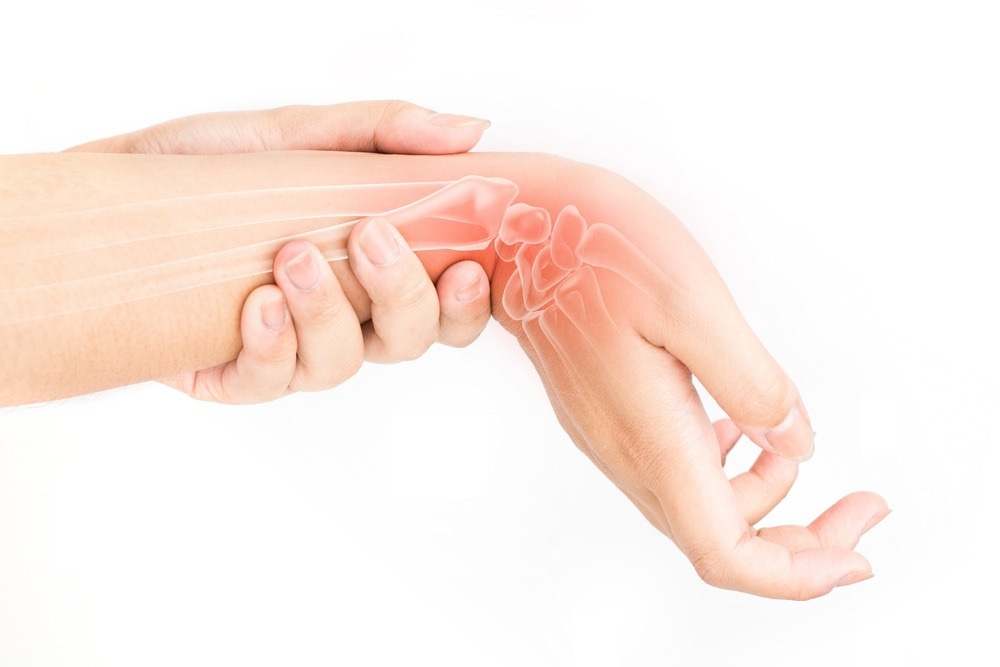Introduction
Conventional treatments for tendonitis
Eccentric strengthening protocol
Other treatment options for tendonitis
References
The primary goal in treating tendonitis (inflammation of the tendons) is to reduce pain and enable activity return. Relative rest of the affected area, stretching, ice and analgesics have been shown as effective approaches to this problem. Surgery is necessary only in severe and protracted cases.

Image Credit: Breslavtsev Oleg/Shutterstock.com
Conventional treatments for tendonitis
Conservative treatments are often used successfully to fight acute symptoms of pain and inflammation; however, they do not modify the histological structure of the tendon. Even when such treatment is started early, the pain can last longer than three months and up to six months if the therapy was delayed for any reason.
The most important step in reducing pain is to rest and thus reduce repetitive loading of the damaged tendon. Still, complete immobilization should be avoided to prevent the development of muscular atrophy. Cryotherapy or icing is also effective for reducing swelling and pain by blunting the inflammatory response. The recommendation is to apply the ice through a wet towel for 10-minute periods.
Nonsteroidal anti-inflammatory drugs (NSAIDs) such as ibuprofen or naproxen effectively reduce inflammation by inhibiting the synthesis of inflammatory cells and other factors, such as prostaglandins. Topical NSAIDs can also reduce pain in tendonitis cases and do not contain risk of gastrointestinal hemorrhage compared to systemic ones.
Corticosteroid injections have some short-term benefits in pain relief, although more research is needed for optimal dosages, intervals, and techniques. Injections are associated with increased pain for the first 24 hours upon application, but therapeutic benefits are evident after three to four days. As tendon rupture can be a side-effect of this treatment, an indication must be carefully evaluated.
Eccentric strengthening protocol
Eccentric exercises are based on the structural adaptation of the muscles and tendons to protect them from increased stresses, preventing re-injury. The basic principles of eccentric strengthening are the length of the tendon, load, and speed.
When the tendon is pre-stretched, its resting length increases, so less strain is put on that tendon during movement. A progressive increase of the load exerted on the tendon results in an increase in the inherent strength of the tendon itself. By increasing the speed of contraction, the development of a greater force ensues.
Eccentric strengthening protocol has proved especially beneficial in Achilles and patellar tendonitis. Exercises should be performed under the supervision of a physical therapist, but when mastered, they can also be done at home.

Image Credit: SoftSheep/Shutterstock.com
Other treatment options for tendonitis
Therapeutic ultrasonography can decrease pain and increase the rate of collagen remodeling producing high-frequency vibrations that generate heat. Extracorporeal shock wave therapy (ESWT) reduces pain and promotes tendon healing via high-energy acoustic shockwaves.
Iontophoresis and phonophoresis employ electric and ultrasonographic impulses to deliver topical corticosteroids or NSAIDs to the subcutaneous tissues. Both methods are widely used, although well-designed randomized controlled trials are lacking.
Surgical evaluation may be warranted if pain persists and the condition becomes chronic despite the conservative treatment and the use of analgesics. The specific type of surgery depends on the tendonitis localization and the estimated damage amount.
References:
- Wilson, J.J. and Best, T.M. (2005). Common Overuse Tendon Problems: A Review and Recommendations for Treatment. American Family Physician, [online] 72(5), pp.811–818. Available at: https://www.aafp.org/pubs/afp/issues/2005/0901/p811.html [Accessed 1 Aug. 2022].
- Maffulli N, Longo UG, Loppini M, Spiezia F, Denaro V. New options in the management of tendinopathy. Open Access J Sports Med. 2010 Mar 31;1:29-37. doi: 10.2147/oajsm.s7751. PMID: 24198540; PMCID: PMC3781852.
- Kaux JF, Forthomme B, Goff CL, Crielaard JM, Croisier JL. Current opinions on tendinopathy. J Sports Sci Med. 2011 Jun 1;10(2):238-53. PMID: 24149868; PMCID: PMC3761855.
- Maffulli N, Longo UG, Loppini M, Spiezia F, Denaro V. New options in the management of tendinopathy. Open Access J Sports Med. 2010 Mar 31;1:29-37. doi: 10.2147/oajsm.s7751. PMID: 24198540; PMCID: PMC3781852.
- Aaos.org. (2010). Achilles Tendinitis - OrthoInfo - AAOS. [online] Available at: https://orthoinfo.aaos.org/en/diseases--conditions/achilles-tendinitis/.
- NHS Choices (2019). Tendonitis. [online] NHS. Available at: https://www.nhs.uk/conditions/tendonitis/.
Further Reading